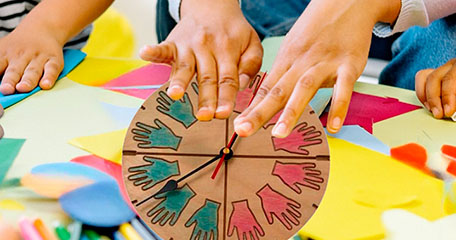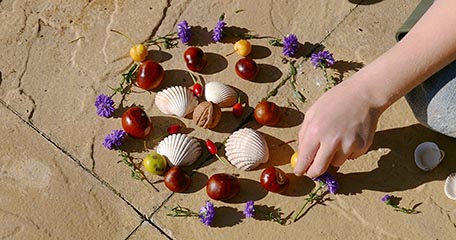Open Mathematics, open minds
Children’s thinking and mathematics
| April 2017Children are naturally biologically wired to be mathematical thinkers even from the very first months of their lives (Sinclair, 1988). It is vital to know and recognise this because as Fleer (2010) reminds us, how we view children determines how we teach them. If we see the child as having no mathematical knowledge then that is how we are going to teach them: as being an empty vessel to fill. However, if we realise that children do bring much to their learning, then we are much more likely to teach in a way that respects that knowledge and builds upon it. The attitude of the adults around a child has a profound effect on her learning.
How we view mathematics and mathematics education is also crucial. If we see mathematics as an exact science with only right and wrong answers, then that also may influence how we teach mathematics. We could teach in a very narrow way, using a step by step approach as in the behaviourist theory of learning (Skinner, 1953). However if we view mathematics education as being more open, then we may see teaching in a very different way. It is this more open mathematics that will support children’s mathematical enquiries.

What is Open Mathematics?
The term ‘Open Mathematics’ was constructed as a result of in-depth discussions with real teachers in real classrooms, and as such it is a grass roots movement. It forms part of my PhD work with nursery and reception class teachers in Bristol, England (Carruthers, 2015; Carruthers and Butcher, 2013; Carruthers 2012). Open Mathematics education starts with looking at mathematics from the whole instead of in parts. For example, we should look at larger numbers that children may be interested in, instead of always teaching 1–5 and then slowly moving up to 5–10. Very young children ask infinity questions, for example “What is the last number?” or “Is a million the biggest number in the world?” Starting with the whole helps children develop a deeper understanding of the parts and the position of the parts. This puts mathematics in mathematical context.
Open Mathematics considers children’s own emerging mathematics, which has no right or wrong answers. Children analyse, hypothesise and experiment and their own thinking is supported, nurtured and developed. This open culture supports a spirit of freedom where children feel free to cross out (for example) their mathematical notation, change their minds and develop their own strategies. Play is recognised as a vehicle for children to express their imaginations, and this is crucial to children’s development of abstract concepts like mathematics. Open Mathematics is not neat and tidy but it involves deep-level learning and sometimes the chaos of thinking, refining and finding new mathematical ideas.
The theoretical stance in Open Mathematics is from a Vygotskian socio-cultural perspective (Vygotsky, 1978). The child’s cultural background and home experiences are seen as valuable and add to their ever growing knowledge base. Socio-cultural theory espouses that children learn from those around them, not just from teachers. Children are soaking up knowledge all the time and school knowledge is only part of this. This is linked to Moll’s (2005) concept that children bring funds of knowledge with them to school and Moll and Gonzalez’s (1994) research on children from poorer households who bring their different – but not lesser – cultural knowledge: “These historically accumulated and culturally developed bodies of knowledge and skills are essential for household or individual functioning and well-being. As households interact within circles of kinship and friendship, children are ‘participant-observers’ of the exchange of goods, services, and symbolic capital which are part of each household’s functioning.” (Moll and González, 1994: 443) This knowledge the children have from home and community is also mathematical as mathematics can be argued to be embedded in everyday living (Pound, 2006).

School Mathematics
School mathematics can sometimes appear disjointed to children and not connected to their own understanding. Hughes’ (1986) research on children and number uncovered that primary children had difficulty with the standard written language of mathematics. Yet in the same study preschool children were able to tackle addition and subtraction using their own ways of solving the algorithms, with more competence compared to the older children. It is clear that the abstract symbolism of mathematics is a problem (Carruthers and Worthington, 2006). To make links between the abstract and the concrete, most Early Years classes use a practical maths approach, and many writers of early childhood maths also emphasise this approach (Threfall, 1992). Resources and manipulatives are used before or with the standard written mathematics. Hughes (1986) and Askew (2001) question if practical mathematics is the answer to support children’s understanding of the abstract.
In our research (Carruthers and Worthington 2006; 2011) we suggest that over using resources (such as in a practical mathematics approach) may make children too reliant on the resources. This makes it even more difficult for children to grasp an understanding of the abstract symbolism. In Open Mathematics children can have freedom to explore their own mathematical thinking in ways they find best. This includes writing, drawing, making tallies and taking ownership of their own mathematical graphics (Carruthers and Worthington, 2006). In Open Mathematics classrooms always have opportunities for children to put down their thinking on paper in any way they find useful. It is this freedom to invent and think through their own mathematics that is vital to learning and understanding. The Williams Mathematics Review (2008) was clear in their recommendations that to secure effective pedagogy there needs to be “a culture with a significant focus on mathematical mark making, in line with early writing; that encourages children to choose their own mathematical graphics to support their mathematical thinking and processes” (DCSF, 2008:26).

Listening to Children’s Mathematics
A key feature in Open Mathematics is really listening to young children to uncover their mathematics and their funds of knowledge. Sometimes we think we are listening, but are we really listening? We need to think about the space in which we discuss mathematics. Is it quiet? Can we hear the child or children? Do we wait through pauses? Who does the talking and do we have the skills to turn round the dialogue so that children feel comfortable to lead the talk? Mercer and Hogkinson (2008) stress that a more dialogical approach in teaching is required and that talk is used as an effective tool for joint enquiry. This collaborative dialogue between teacher and child makes all the difference to the learning (Siraj-Blatchford 2009)
In mathematics Boaler reminds us that: “Mathematics is learned by computing, by solving problems and by conversing more than reading and listening” (Boaler 2009:26).
Conversation and learning how to converse are so important for learning. Real conversations bring equity and create no pressure to speak. They are not about turn taking, children or adults speak when they have something to say. The adult can take the role of facilitator and stimulate the conversation. It is easier to listen to a conversation that you are engaged in and also easier to remember the flow when you are part of the thinking.
Do we understand Children’s Mathematics?
In my own research (Carruthers, 2015) with nursery school and reception teachers, the findings revealed the importance of the relationship with the key person in the child’s school or nursery world. Children’s sense of trust, attachment and relationship between themselves and their key person/teacher is vital to the mathematics being understood by the child. As the key person tunes into the child’s understandings and mathematical meanings, they instinctively know how to respond and support the child’s mathematical thinking.
Children’s play and mathematics
Play is such a part of children and childhood, yet it is highly debated and complex. Vygotsky in his research into children’s play argued, “Superficially, play bears little resemblance to the complex, mediated form of thought and volition it leads to” (1978:104). Wood argues that “what play is, what play means and what play does for the player is conceptualised in different ways according to the particular lenses through which research views play” (2010:12). The play that supports children’s mathematics is child led and owned. It is what Bruce (2004) describes as free flow play. If play is restricted to adult-led outcomes then it restricts the children’s exploration and choices in mathematics. Play is central to Open Mathematics because it gives that intellectual freedom to children that is so necessary to learning. Imaginary play helps children to think beyond the literal, they can use a chair to be a pirate ship, even though the chair does not resemble a ship. This can be said to be abstract thought, necessary to mathematics.

Conclusion
There are many aspects of Open Mathematics, but more than anything it is about creating a culture of mathematical enquiry where mathematics is woven through the day and not limited to a set disjointed activity. Problem-solving is at the heart of mathematics and linked to children’s own enquiries that arise out of their interests and every day happenings. Play is central to young children’s mathematics. Open Mathematics is underpinned by a democratic pedagogy where children and adults co-construct learning. Teachers and practitioners actively seek knowledge about children’s learning both from the children they teach and their engagement with a professional learning community.
References
Boaler, J. The Elephant in the Classroom: Helping Children to Love Maths. London: Souvenir Press.
Bruce, T. (2004) Developing Learning in Early Childhood. London: Sage
Carruthers E. 2015 Listening to Children’s Mathematics in School. In Perry B, Macdonald, A. and Gervasoni, A. Mathematics and Transition to School; International Perspectives. Springer, New York.
Carruthers E. and Butcher, E. (2013) Mathematics: Young children co-construct their mathematical enquiries. In Beckley, P. (ed.) Early Years Foundation Stage, Maidenhead: Open University Press.
Carruthers E. and Worthington M. 2011 Understanding Children’s Mathematical Graphics, Open University Press, Maidenhead.
Carruthers E. and Worthington M. 2006 Children’s Mathematics; Making Marks, Making Meaning, Sage, London.
DCSF (2008) Independent Review of Mathematics Teaching in Early Years Settings and Primary Schools. Final Report – Sir Peter Williams, June 20018 London: DCSF publications.
Fleer, (2010) Early Learning and Development: Cultural-historical concepts in play. Cambridge: Cambridge University Press
Hughes (1986) Children and Number; Difficulties in learning Mathematics. Basil Blackwell, Oxford.
Mercer, N. and Hodgkins, S. (2008) Exploring Talk in School, Sage, London.
Moll, L.C., (2005) Reflections and possibilities. In: N González, L Moll and C Amanti (eds) Funds of Knowledge: Theorizing Practices in Households, Communities, and Classrooms, pp. 275–88. Mahwah, NJ: Lawrence Erlbaum Associates.
Moll L and González N., (1994) Lessons from research with language minority children. Journal of Reading Behavior 25: 439–56.
Pound, L. (2006) Supporting Mathematical Development in the Early Years, 2nd edn. Maidenhead.
Sinclair, A. (1988) ‘La notation numerique chez infant’, in A. Sinclair (ed.), La production se Notation chez le Jeune Enfant: langue, nombres, rythmes et melodies. Paris: Presses Universitaires de Frances
Siraj-Blatchford, I. (2009). Conceptualising progression in the pedagogy of play and sustained shared thinking in early childhood education: a Vygotskian perspective. Education and Child Psychology, 26 (2), 77-89.
Skinner, B. F. (1953). Science and human behavior. SimonandSchuster.com
Threfall, J. 1992 ‘No sums please we’re infants’ Education 3-13, 20 (2), 15-17.
Wood E. (2010) Developing integrated pedagogical approaches to play and learning, in P. Broadhead, L. Wood and J. Howard (eds) Play and Learning in Educational Settings. London: Sage.
Vygotsky L. S. (1978) Mind and Society: The development of higher mental processes. Cambridge, MA: Harvard University Press.





